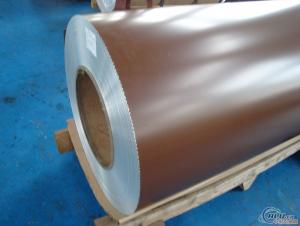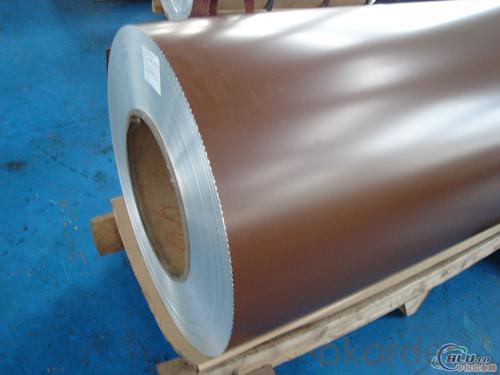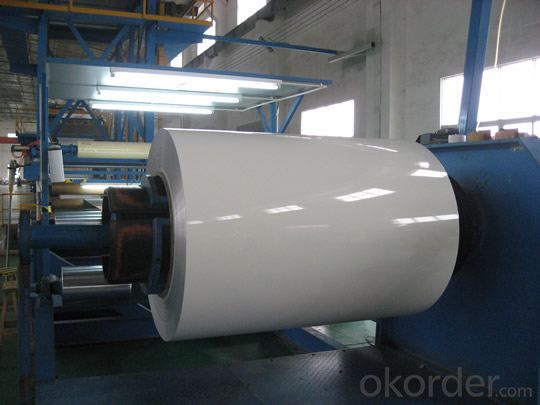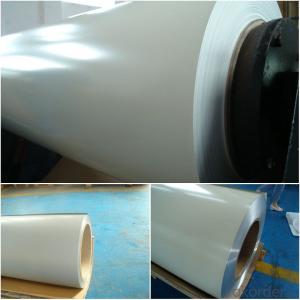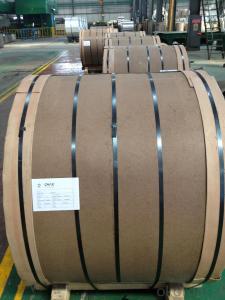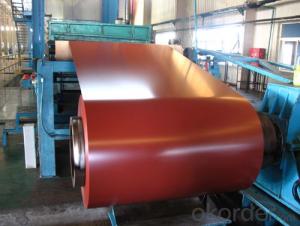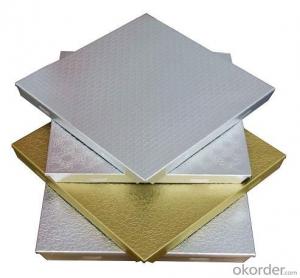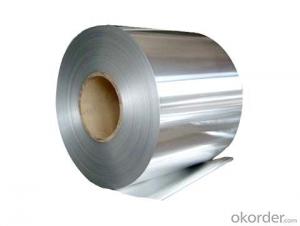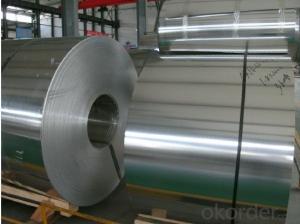Aluminum Coil Sheet - Color Coated Polyester for Windows
- Loading Port:
- China Main Port
- Payment Terms:
- TT or LC
- Min Order Qty:
- -
- Supply Capability:
- -
OKorder Service Pledge
OKorder Financial Service
You Might Also Like
1.Structure of Aluminium Color Coated for Windows Description
PE Coated aluminium coils are widly used in decoration field. For the painting, it depends on the using evironment. If you use in the open air, we recommend the PVDF coated aluminium coils. This kind of painting can last 15-20 years. If you use in the room, we recommend PE coated aluminium coils. The price is much more competitive.
2. Main features of the product
a.Competitive price---We have our own mills and can produce mill finished aluminium coils, so we can control the production cost better.
b.Professional after-sale service---We have more than 15 years exportation experience and you need not worry about the exporation problems.
c.Fast delivery time---We can control the delivery time within 35 days.
3. Image
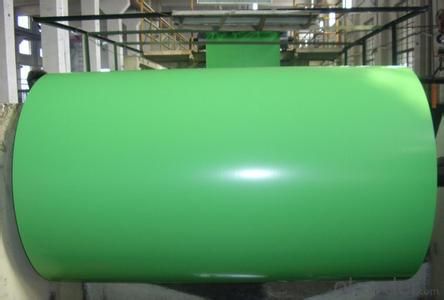
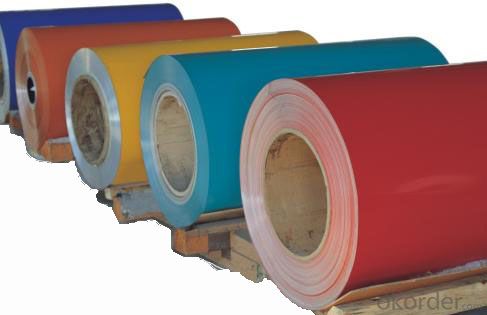
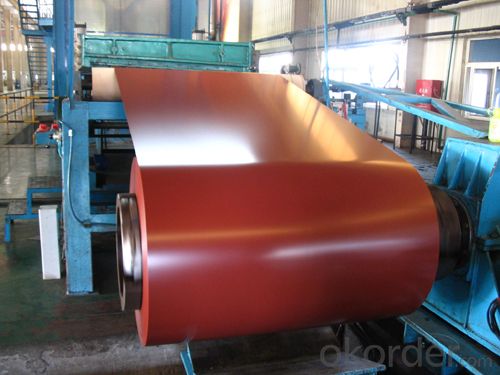
4. Products Specification
| Alloy | Paints | Coating Thickness | Period | Final Usage |
| AA3003 | PE | 22-25 MICRONS | 10-15 YEARS | WINDOWS |
5.FAQ
What is the quality standard?
---Usually our standard is GB3880-2006
What is the largest width?
---It is 2300mm
What is the MOQ?
---Usually we can accept 80 tons.
- Q: what language did Aluminum and Uranium originate from ? Who or what were they named for ?
- The ancient Greeks and Romans used alumen (alum, potassium aluminium sulfate, K2Al6(OH)12(SO4)4) in medicine as an astringent, and as a mordant in dyeing. Alum was exported from ancient Greece and Italy. In 1761 the French chemist Louis-Bernard Guyton de Morveau (1737-1816) proposed the name alumine for the base in alum. Guyton de Morveau was instrumental in setting up a standardised system for chemical nomenclature and often collaborated with Antoine Lavoisier, who in 1787, suggested that alumine was the oxide of a previously undiscovered metal. In 1808, Sir Humphry Davy (1778-1829) did experiments for the decomposition of alumine, silex, zircone, and glucine. He failed to isolate the metals in these, as he reported in his paper for the Royal Society of London on 30 June 1808, but he suggested names for the metals (note) Cf. Silicium, Zirconium, and Beryllium (Glucium) Thus he proposed the name alumium for this still undiscovered metal and later agreed to change it to aluminum. Shortly thereafter the name aluminium was adopted to conform with the -ium ending of most elements. Uranium was named by its discoverer German chemist Martin Klaproth, after the last planet to have been discovered Uranus.
- Q: Is it safe and practical to utilize aluminum coils for food storage purposes?
- <p>Aluminum coils can be used for storing food, but it's important to consider the type of food and the conditions. Aluminum is a good conductor of heat, making it suitable for cooking and preserving food in certain contexts, such as in foil form for wrapping food for baking or grilling. However, for long-term storage, especially of acidic or alkaline foods, aluminum may not be ideal due to potential leaching of aluminum into the food, which could be harmful. It's also crucial to ensure that the aluminum is food-grade and not contaminated with harmful substances. For most food storage needs, other materials like glass, stainless steel, or food-grade plastic are often preferred due to their non-reactive nature and safety.</p>
- Q: Can aluminum coils be used in the production of aluminum facades?
- Yes, aluminum coils can be used in the production of aluminum facades. Aluminum coils are commonly used in the construction industry for various applications, including the production of facades. The coils are typically made from high-quality aluminum alloy, which offers excellent durability, corrosion resistance, and aesthetic appeal. The coils can be easily shaped, cut, and formed to create the desired design and size for the aluminum facades. Additionally, aluminum coils can be coated with different finishes, such as powder coating or anodizing, to provide further protection and enhance the appearance of the facades. Overall, aluminum coils are a versatile and reliable material for the production of aluminum facades, offering a wide range of design possibilities and long-lasting performance.
- Q: Can aluminum coils be used for window frames?
- Certainly, window frames can indeed be made using aluminum coils. Aluminum is widely favored for window frames owing to its enduring nature, lightweight composition, and ability to resist corrosion. It is extensively employed in both residential and commercial settings. Aluminum coils can be effortlessly molded and adjusted to accommodate diverse window dimensions and designs. Additionally, aluminum frames provide exceptional thermal insulation qualities, thereby enhancing energy efficiency in structures. All in all, aluminum coils represent a dependable and pragmatic choice for constructing window frames.
- Q: How to identify the quality of color coated aluminum coil and sheet?
- Color coated aluminum coil is a kind of aluminum coil. As for qualified color coated aluminum coil, the surface has no impression, holiday and damage through the coating, and also no ripple, scratch and swell. All these are easy to see. However, the most important is the color difference of the color coated aluminum coil which is not obvious but will influence the decoration effect. Now the surface of curtain wall aluminum sheet will also be treated with electrostatic spraying. The power coating materials can have dozens of colors and realize good decorative effect, with polyurethane, polyethylene expansion resin and epoxy resin as raw materials, high color retention pigment as auxiliaries.
- Q: What is the thermal conductivity of aluminum coils?
- The thermal conductivity of aluminum coils is high, making them efficient in transferring heat.
- Q: This question asks for a comparison between aluminum coils and other metal coils, highlighting their distinct characteristics.
- <p>Aluminum coil is distinct from other metal coils due to its lightweight, high corrosion resistance, and excellent thermal and electrical conductivity. Compared to steel coils, aluminum coils are softer and more ductile, making them easier to bend and shape without breaking. They are also non-magnetic and have a lower melting point. Copper coils, on the other hand, have superior electrical conductivity but are heavier and more expensive. Zinc coils offer good corrosion resistance but are less ductile and have lower strength. Each metal coil has specific properties that make them suitable for different applications, such as construction, electrical wiring, or automotive parts.</p>
- Q: Can aluminum coils be used in automotive manufacturing?
- Automotive manufacturing can indeed utilize aluminum coils. Aluminum, a versatile and lightweight substance, presents several advantages within the automotive sector. Frequently employed for fabricating components such as body panels, engine blocks, wheels, and heat exchangers, aluminum's incorporation in automotive manufacturing enhances fuel efficiency by reducing vehicle weight and subsequently minimizing energy consumption. Furthermore, aluminum boasts exceptional resistance to corrosion, rendering it appropriate for deployment in diverse weather conditions. In conclusion, the extensive benefits associated with the utilization of aluminum coils in automotive manufacturing have led to its widespread adoption by numerous car manufacturers.
- Q: How do aluminum coils compare to stainless steel coils in terms of durability?
- When it comes to durability, there is a notable distinction between aluminum coils and stainless steel coils. In general, stainless steel coils are regarded as more long-lasting compared to their aluminum counterparts. This is primarily due to the fact that stainless steel possesses exceptional resistance to corrosion and has a longer lifespan. Stainless steel's resistance to corrosion is higher, making it ideal for utilization in challenging settings or situations where exposure to moisture, chemicals, or high temperatures is prevalent. It is less prone to rusting or developing corrosion spots, ensuring a lengthier existence and preserving its structural integrity over time. On the flip side, aluminum coils are more susceptible to corrosion, particularly in environments with high humidity, saltwater, or acidic conditions. To enhance their corrosion resistance, aluminum coils are often coated or treated. However, despite these measures, they may still be susceptible to corrosion over time, which can compromise their durability. However, it is important to note that the durability of both aluminum and stainless steel coils can also be influenced by other factors including the quality of the materials, the manufacturing process employed, and the level of maintenance and care provided. Regular cleaning, appropriate storage, and preventive measures can contribute to extending the lifespan of both types of coils. To summarize, although both aluminum and stainless steel coils have their own advantages and disadvantages, stainless steel coils typically offer superior durability due to their heightened resistance to corrosion. Nevertheless, when determining the most suitable option for a specific situation, it is essential to also consider the specific application, environment, and maintenance practices involved.
- Q: How are aluminum coils manufactured to specific dimensions?
- Precision engineering and cutting-edge technology are utilized to manufacture aluminum coils with specific dimensions. The process commences with the selection of high-quality aluminum ingots, which are subsequently melted and cast into long, flat strips. Upon achieving the form of flat strips, the aluminum undergoes a sequence of rolling operations. The strips pass through a rolling mill, gradually decreasing in thickness and elongating in length. This rolling process is instrumental in attaining the desired dimensions and thickness for the coils. Following the initial rolling, the strips undergo annealing, a process involving heating the aluminum to a specific temperature and then cooling it slowly. This procedure enhances the ductility and reduces internal stresses in the metal, making it more manageable for subsequent manufacturing steps. The subsequent step is slitting, which involves cutting the wide strip into narrower strips of the desired width. High-precision slitting machines ensure accurate and consistent dimensions for each coil. Additionally, edge trimming is performed during the slitting process to eliminate irregularities and ensure straight edges. Once the narrower strips are obtained, specialized machines are utilized to coil them. These machines carefully wind the strips into coils of the desired size and shape, ensuring secure and tight winding. To further enhance dimensional accuracy, the coils may undergo a final leveling process. This process entails passing the coils through a machine that applies pressure to flatten any irregularities or distortions in the metal, ensuring a uniform and consistent thickness. In summary, the manufacturing of aluminum coils with specific dimensions necessitates a combination of precision rolling, slitting, coiling, and leveling processes. These processes, in conjunction with advanced machinery and quality control measures, guarantee that the final product meets the precise specifications required by the customer.
Send your message to us
Aluminum Coil Sheet - Color Coated Polyester for Windows
- Loading Port:
- China Main Port
- Payment Terms:
- TT or LC
- Min Order Qty:
- -
- Supply Capability:
- -
OKorder Service Pledge
OKorder Financial Service
Similar products
Hot products
Hot Searches
Related keywords
